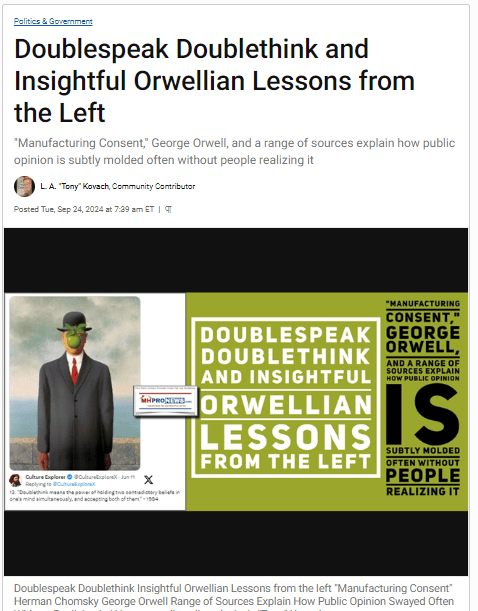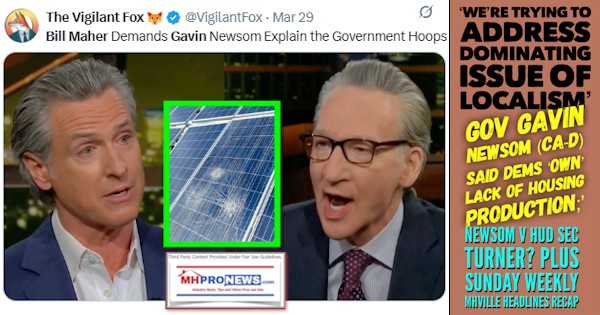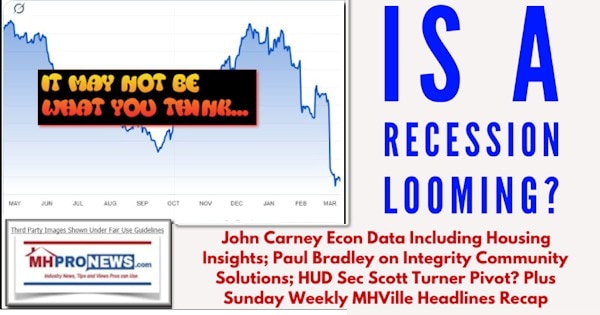
Left-leaning Google’s Gemini says: “The phrase “news is the first rough draft of history” is attributed to Philip L. Graham, the former publisher of The Washington Post, meaning that news reporting provides an initial, incomplete account of events that can be further refined and expanded upon by historians later on; essentially, journalism is the first attempt to document current events, which can be revised and added to over time to create a complete historical record.” At MHProNews our goal is to make news less hasty, more accurate and give it greater context than many (not all) others in the news media offer. Perhaps as a result of our methodology in reports with analysis that aim to share insights with truth and accuracy in mind, our audience didn’t crater after the 2024 election as did some big multi-billion-dollar names in mainstream media. While our scope, budgets and focus are more about affordable manufactured housing, MHProNews began weaving in select mainstream news items so as to shed light on why HUD Code manufactured housing was underperforming during an affordable housing crisis. That’s “News through the lens of manufactured homes and factory-built housing” © where “We Provide, You Decide©.” Readers like you have made us the dominating number one source for MHVille “Industry News, Tips, and Views” © for years, as left-leaning Bing’s AI powered Copilot has confirmed. Interestingly, one of the economic winners in our look back at 2024 provided by the Daily Signal in Part I of this report with analysis is AI.
According to Copilot, only MHProNews and MHLivingNews have regularly offered AI enhanced analysis in manufactured housing trade media. We began that process in May 2023, with the use of AI in an article clearly disclosed. This has given our readers an opportunity to double check our fact checks with analysis for themselves.
While our articles are often longer than most news outlets tend to provide our information in MHProNews routinely stands the test of time. Restated, news properly presented isn’t as rough as what Phil Graham mused about in his famous phrase quoted above.
With no further adieu, here is the Daily Signal’s apparently thoughtful look back at 2024 in Part I followed by additional information from cited sources along with our MHProNews analysis and commentary in Part II.
Part I
THAT’S A WRAP: The Political Winners and Losers of 2024
For those of us in the news business, 2024 provided a steady stream of stories to cover—and rarely a dull moment. From the Republican primaries early in the year to the assassination attempts and political conventions this summer, our Daily Signal team stayed busy through Election Day and in the days that followed.
During his first term as president, Donald Trump provided a plethora of political and policy news for us to report. We expect the same will be true in 2025. But before we turn the page on this year, our team reflected on the winners and losers—compiling the following list (listed alphabetically).
How’d we do? Send us a note at letters@dailysignal.com to compliment us to complain about our choices. We welcome your feedback and look forward to hearing from you.
The Daily Signal depends on the support of readers like you. Donate now
Winners
AI
In 2024, you couldn’t escape artificial intelligence even if you tried.
Companies like Anthropic, OpenAI, and others released new AI models and expanded their capabilities. Their consumer-friendly tools like Claude and ChatGPT continued to become more powerful.
Elon Musk (also on this list) is building his own rival, rolling out improvements to Grok, his version of AI within X. “We will have something that is, for the first time, smarter than the smartest human,” Musk has predicted.
With big questions about government regulation and its application in everyday life, this technology is truly, in Musk’s words, “the most disruptive force in history.”
Joe Biden

Yes, you read that right. What is left of President Joe Biden is a winner in the year of our Lord 2024. Even though Biden’s own party threw a coup against him (the sitting president of the United States!) and removed him from the presidential race, the flip at the top of the ticket ended up being a flop.
Trump carried the Electoral College and the popular vote in his mandate victory. Now, it’s a serious question as to whether Biden would have performed better in the places that mattered most to carry the presidential election—Pennsylvania, Michigan, Wisconsin.
Biden was a party man for half a century, but ever since Democrats switched Biden for Kamala Harris, Biden has seemingly helped Republicans at every turn and acted purely out of self-interest.
His loyalists leaked details of the coup and Democrat infighting to the press, he wore a MAGA hat, and he gave Republicans a last-minute turnout boost by calling Trump supporters garbage. And, of course, since losing the election, he’s pardoned his son, Hunter Biden, after promising for years he would not. He’s created one political mess after another, and the Democratic party will be left to clean it up. Meanwhile, the president and his son will be on the beach in Delaware.
Bitcoin
The price of bitcoin was $44,000 on Jan. 1 and exceeded $100,000 in the weeks following Trump’s election.
With crypto-friendly officials dotting Trump’s new administration, there’s genuine excitement about its future. Paul Atkins is set to replace Gary Gensler as chairman of the Security and Exchange Commission and billionaire David Sacks, co-host of the “All In” podcast, will serve as Trump’s AI and crypto czar.
Dennis Porter, CEO and co-founder of the Satoshi Action Fund, told The Daily Signal that cryptocurrency like bitcoin can combat inflation and preserve individual freedom.
“You are able to operate wholly on your own with no third parties, without asking permission, you are able to access the bitcoin network globally, anywhere in the world and be able to participate in the economy without asking permission,” Porter said.
Tucker Carlson

After leaving Fox News and launching his own Tucker Carlson Network in 2023, the popular conservative commentator continued to influence the Republican Party’s agenda under Trump.
Known for his populist and common-sense perspectives, Carlson propelled to the top of the charts with millions watching or listening to his interviews and monologues.
His trip to Russia for a two-hour conversation with Vladimir Putin has more than 20 million views on YouTube. Another interview with El Salvador President Nayib Bukele has more than 5 million, reflecting Carlson’s international reach.
Tucker Carlson Films expanded his content offerings even further. “The Art of the Surge,” a series produced by Justin Wells, offered viewers a behind-the-scenes look at Trump’s historic comeback, including shocking footage from the Butler, Pennsylvania, assassination attempt.
In September, Carlson hit the road for a cross-country speaking tour that featured conservative newsmakers, drawing sold-out crowds to hear from the likes of JD Vance, Donald Trump Jr., and Robert F. Kennedy Jr., Tulsi Gabbard, and Vivek Ramaswamy.
Dogs and Cats
At their only debate in September, Trump and Harris squared off on a range of policy issues. But the most memorable moment came amid reports of Haitian immigrants overwhelming the community of Springfield, Ohio.
“In Springfield, they are eating the dogs. The people that came in, they are eating the cats. They’re eating—they are eating the pets of the people that live there,” Trump said.
ABC News anchor David Muir, who repeatedly interjected during the debate, attempted to correct Trump. But it didn’t matter.
The story dominated the news for days as Americans saw Springfield as a representation of America’s broken immigration system. An estimated 20,000 immigrants were living in the community of 60,000.
Fox News

In a year when other TV networks lost viewers—and respect—Fox News maintained its position as the leader in cable news.
“Fox News Channel obliterated competitors in 2024, finishing the year with its highest share of the cable news audience since 2015,” Brian Flood reported for Fox News Digital.
Since the Nov. 5 election, Fox News has dominated its competition—both cable and network TV—with more than 4 million prime-time viewers (from 8-11 p.m. ET), according to Nielsen Media Research data. That makes Fox News the most-watched network, beating legacy media networks ABC, CBS, and NBC in prime-time.
In terms of market share, Fox News commanded 73% of the prime-time cable news audience as CNN’s and MSNBC’s ratings cratered following Trump’s victory.
Podcasters and social media personalities are getting deserved praise for their growing influence, but Fox News Channel is still the go-to destination for political and election news.

Tom Homan
Homan was among the first political figures Trump tapped for his new administration following his victory on Nov. 5.
After serving at the acting director of Immigration and Customs Enforcement under the first Trump administration, Homan will now serve as Trump’s border czar and lead the way on Trump’s mass deportation plan.
Homan spent the last four years watching the Biden administration welcome over 10 million illegal aliens into the county, and now, with the full support of the president, he will have the opportunity to enforce U.S. immigration law and secure a border that he has spent his career defending, both in the Border Patrol and ICE.
Patrick and Brittany Mahomes

The three-time Super Bowl champion quarterback for the Kansas City Chiefs orchestrated an overtime victory in February and has his team positioned for another appearance in 2025.
Patrick’s wife, Brittany, made headlines of her own when she liked an Instagram post of then-candidate Trump about the Republican Party’s platform. After facing a backlash, she wrote, “Jesus didn’t have to agree with people to be kind to them.”
Two other members of the Mahomes family endorsed Trump: Patrick’s younger brother Jackson and his mother Randi, who showed up to a Chiefs’ game in a MAGA hat.
McDonald’s

The iconic American fast-food restaurant found itself at the center of news on several occasions.
Donald Trump’s October campaign stop at a McDonald’s in the Philadelphia suburbs was a brilliant photo opportunity for the Republican candidate. But it also symbolized the difference between his appeal to working-class Americans in contrast to Kamala Harris.
Trump wore an apron and worked as a fry attendant. It was one of the most viral moments of the 2024 presidential election and a classic Trump move, particularly given Harris’ questionable employment at McDonald’s earlier in her life.
“As we’ve seen, our brand has been a fixture of conversation this election cycle. While we’ve not sought this, it’s a testament to how much McDonald’s resonates with so many Americans,” McDonald’s wrote after Trump’s visit. “McDonald’s does not endorse candidates for elected office and that remains true in this race for the next President. We are not red or blue—we are golden.”
McDonald’s made news again in December when a customer in an Altoona, Pennsylvania, restaurant spotted murder suspect Luigi Mangione, leading to his arrest.
Elon Musk

Elon Musk’s purchase of Twitter, and his transformation of the platform into the free speech engine that is X today, likely helped Trump’s historic election victory. Musk also contributed to that victory by endorsing Trump and urging swing-state voters to sign his petition for the chance at winning $1 million.
Musk not only played a historic role in the election; he will also help lead the Department of Government Efficiency, an external advisory board to trim waste and prevent abuse in the federal government.
In December, Musk rallied Americans on X to oppose a must-pass government funding bill that had been stuffed with pork. His opposition to the bill grew naturally out of his work on the Department of Government Efficiency and his efforts led Trump to oppose the bill and House Speaker Mike Johnson to withdraw it from consideration.
Podcasters
Podcasting took center stage this year, with 2024 being the first ever “podcast election,” and for good reason.
Over 53 million Americans tuned in to hear Trump’s three-hour conversation with Joe Rogan covering everything under the sun—from tariffs to golfing to fixing the “wrongs” of his first term. America also watched Vance communicate Trump’s vision for the country over the next four years with Theo Von—all while proving he can joke around and isn’t “weird.” Even Kamala Harris’ failed campaign hopped on the podcast bandwagon with a 45-minute appearance on “Call Her Daddy.”
But why the sudden interest in podcasts? Americans are fed up the corporate media lies, so they fled to a more uncensored platform. An October Gallup poll revealed that trust in the media hit a historic low, with 36% saying they have “no trust at all in the media,” and 33% expressing “not very much” confidence.
Now, everyone and their mother—from CNN’s Chris Wallace to former Republican presidential candidate Nikki Haley—are scrambling to hop on the podcasting wave. The Daily Signal launched a brand-new podcast this year, “The Signal Sitdown,” where members of Congress explain how the sausage really gets made in Washington, DC.
Dennis Quaid

The longtime Hollywood actor starred in the hit movie “Reagan.”
Based on Paul Kengor’s book, “The Crusader: Ronald Reagan and the Fall of Communism,” the movie was a box-office success. It made more than $30 million worldwide, far exceeding expectations.
Quaid’s performance was a big reason for the movie’s success.
“Dennis was always my first choice because he required almost no hair and makeup touchups to get him camera-ready,” producer Mark Joseph told The Daily Signal. “He’s a natural, and he has that great Reaganesque smile and persona. He’s a busy guy, so it took some time to nail him down, but he was always the one for me.”
Joe Rogan

In the weeks before Election Day, Trump shunned CBS News’ “60 Minutes” and other corporate media outlets in favor of modern-day influencers like Joe Rogan, Theo Von, and Logan Paul. Megyn Kelly, whose show is regularly among the top 10 podcasts, joined Trump on the campaign trail in Pittsburgh.
Trump’s interviews with these influencers accumulated more than 100 million views—and reached voters who don’t get their news from traditional media sources.
Donald Trump Jr. told Daily Wire podcast host Michael Knowles that he and his father discussed giving Rogan a press pass to the White House to shake up the status quo.
“I was sitting there, and we were talking about, like, the podcast world, and some of our friends, and [Joe] Rogan, and guys like you, and me to a lesser extent—I wouldn’t be able to get a seat, that would be nepotism or whatever the hell,” Trump Jr. said. “But we had the conversation about opening up the press room to a lot of these independent journalists.”
Trump has disrupted the corporate media’s business as usual, and Rogan appears to be coming out on top.
Josh Shapiro
Pennsylvania’s Democrat governor was on the short list to become Kamala Harris’ vice president. Instead, Harris picked Minnesota Gov. Tim Walz after a few notable TV appearances
In retrospect, Shapiro should count his blessings.
After a strong debut in August, Harris failed to live up to the fanfare down the stretch. Walz will be an afterthought in the history books.
Shapiro, meanwhile, can now position himself for a future presidential run without Harris’ baggage. He’ll need to win reelection in 2026 and then overcome the left’s fears about his support for Israel and past endorsement of school choice.
Donald Trump

After easily vanquishing his Republican rivals in the GOP primaries, Donald Trump did the same to the incumbent president. Joe Biden was no match for his predecessor after their June debate, setting into motion an unprecedented turn of events over the summer that resulted in Vice President Kamala Harris being anointed the Democrat nominee—without winning a single vote.
As if those political hurdles weren’t enough, Trump also emerged unscathed from the Left’s lawfare and then survived two assassination attempts on his life. A bullet came within mere centimeters of killing him in Butler, Pennsylvania, on July 13.
Heading into Election Day, legacy media outlets were convinced it was a toss-up race between Harris and Trump. Instead, it turned out to be a historic Trump mandate, sweeping all seven swing states, capturing the popular vote, and making major gains with blacks, Hispanics, and younger Americans.
As he departed the White House in 2021, Trump left at a political low point. Few pundits gave him a chance at redemption, and yet Americans witnessed in 2024 the greatest political comeback in U.S. history. With Biden already AWOL, Trump is wasting little time to make his mark, recognizing the precious little time he has to implement his policy engage, deliver on his promises, and finally drain the swamp in Washington, D.C.
Losers
College Presidents

Anti-Israel protests continued to rock college campuses. They also ended the careers of three Ivy League university presidents.
Liz Magill of the University of Pennsylvania resigned in December 2023, the first of three presidents to lose their jobs. Harvard’s Claudine Gay stepped down in January and Columbia’s Minouche Shafik in August.
Magill and Gay’s downfall came after facing off against Rep. Elise Stefanik, R-N.Y., at a congressional hearing. Shafik was unable to handle antisemitic protests at Columbia.
“THREE DOWN, so many to go,” Stefanik said. “We will continue to demand moral clarity, condemnation of antisemitism, protection of Jewish students and faculty, and stronger leadership from American higher education institutions.”
As the year drew to a close, George Mason University President Gregory Washington found himself under scrutiny for its own problems. Three of its students, all of Middle Eastern origin, had run-ins with the police over weapons and pro-terror material.
Mark Cuban

Best known for his role on “Shark Tank,” the Dallas Mavericks owner was among the most vociferous defenders of Harris when she replaced Biden atop the ticket.
Cuban appeared at campaign rallies, on television, and regularly engaged online in support of the Democrat presidential candidate. He extreme rhetoric—calling Trump a “threat” with “fascist tendencies”—epitomized the left’s hyperbolic language.
At one point during the campaign, he admitted to ABC News that “Harris is just not a good salesperson,” prompting his own involvement in the race.
Some pundits speculated that Cuban wanted a high-profile job in a Harris administration, perhaps leading the Securities and Exchange Commission. Instead, he’ll be watching the action from the sidelines.
After Trump’s victory, Cuban wrote on Bluesky, “Don’t expect any politics or speculation about what might happen for a while.”
Nikki Haley

After suspending her political campaign in March, Haley has found herself somewhat politically homeless among a shifting Republican Party.
Haley was a fierce critic of Trump during the 2024 presidential race, despite serving as ambassador to the U.N. under a portion of his first administration. Though Haley made an appearance at the Republican National Convention, Trump was clear after his victory that there was no place for Haley in his administration.
“I will not be inviting former Ambassador Nikki Haley, or former Secretary of State Mike Pompeo, to join the Trump Administration, which is currently in formation,” Trump wrote on Truth Social in November.
Haley is now working in the private sector at Edelman, a global communications firm.
Sunny Hostin

What was supposed to be a friendly question for Kamala Harris turned into a disaster. Appearing on “The View” in early October, Hostin asked Harris if she would do anything differently from Biden.
“There is not a thing that comes to mind,” Harris replied.
The answer surprised even friendly Hostin, who followed up to give Harris another opportunity. After the election, Hostin admitted that Harris missed the mark.
“The reason I followed up was because that wasn’t a gotcha question,” Hostin said. “That was a layup, really.”
Trump campaign spokesman Jason Miller pointed to the interview as a turning point in the campaign.
“I think this Kamala Harris strategy of going out and doing a whole bunch of media has really backfired. I mean, who would’ve thought that Sunny Hostin from The View really killed Kamala Harris’ candidacy?” Miller said.
Legacy Media
Election Day was not just a high-stakes contest of competing visions for America’s political institutions and future. It was about the future of our other commanding heights institutions as well—academia, finance, the media, and the like.
None of these institutions or industries had as high of stakes as the media: 2024’s campaign cycle was a test to see if the corporate media could put an empty suit (whether by the name of Joe Biden or Kamala Harris) in the White House, or if alternative media could pose a real threat to the corporate media’s power.
Trump’s victory, not to mention conservative control of the House and Senate, proved the latter.
To add insult to injury, ABC has agreed to pay Trump $15 million to settle a defamation lawsuit after George Stephanopoulos falsely claimed Trump was found “liable for rape.” For some reason, the corporate press feels threatened by this settlement. “Trump is already delivering on his promise to go after the press,” one Politico headline read.
If going after the press means the corporate media can no longer spread malicious lies with impunity, Americans ought to hope Trump delivers on this promise tenfold.
Mitch McConnell

Senate Republicans will have a new leader for the first time in 18 years—and there’s palpable excitement on Capitol Hill for the changing of the guard.
Sen. Mitch McConnell, R-Ky., stepped down from his leadership perch after pressure from conservatives and his own health problems. He’ll serve out the remainder of his term, which ends in 2027.
In recent years, McConnell made more headlines for his clashes with Trump and the MAGA movement than any legislative accomplishments. Even on his way out, he couldn’t help taking a shot at Trump.
“To pretend that the United States can focus on just one threat at a time, that its credibility is divisible, or that it can afford to shrug off faraway chaos as irrelevant is to ignore its global interests and its adversaries’ global designs,” McConnell wrote in Foreign Affairs. “America will not be made great again by those who simply want to manage its decline.”
McConnell leaves his leadership job as one of America’s most unpopular politicians.
His successor, Sen. John Thune, R-S.D., won a three-way race for the top job. Even though he wasn’t the first choice of MAGA voters, Thune has signaled support for Trump’s agenda and nominees.
Planned Parenthood
Pro-life voters ended their losing streak at the ballot box, stopping three statewide constitutional amendments in support of abortion.
Those wins in Florida, Nebraska, and South Dakota give the pro-life cause a reason for optimism, even as measures passed in seven other states.
More importantly, the left’s pro-abortion enthusiasm appeared to wane at the ballot box. Unlike the 2022 midterm election, when the issue halted the Republican “red wave,” this time Democrats were on defense for a range of other issues, including inflation, border security, and crime.
With the incoming Trump administration poised to restore pro-life protections, Planned Parenthood will also be a target of Congress. The abortion giant relies on taxpayer funding for its operations.
In recent years, Planned Parenthood has expanded its portfolio to include transgender services. Abortion remains its priority, however. With approximately 200 abortions for every adoption referral, there’s no mistaking this organization’s evil intentions.
Taylor Swift

Among the major celebrities endorsing Harris, there was no one bigger than Taylor Swift. But just like her uninspiring 2018 endorsement of Sen. Marsha Blackburn’s Democrat opponent in Tennessee, Swift’s embrace of Harris ended with a loss.
Swift weighed in after the presidential debate between Harris and Trump in September.
“I think she is a steady-handed, gifted leader and I believe we can accomplish so much more in this country if we are led by calm and not chaos,” Swift wrote on Instagram. “I was so heartened and impressed by her selection of running mate [Tim Walz], who has been standing up for LGBTQ+ rights, IVF, and a woman’s right to her own body for decades.”
She signed the note, “Childless Cat Lady,” in reference to a comment Sen. JD Vance made in an earlier interview.
Swift should stick to her day job. Her popular Eras Tour was far more successful than her political picks.
The Woke Bureaucracy
As Tyler O’Neil’s forthcoming book “The Woketopus: The Dark Money Cabal Manipulating the Federal Government” reveals, the Left’s dark money network props up a system of woke nonprofits that staff and advise the federal government, pushing the bureaucracy to support critical race theory (the notion that America is systemically racist against blacks and for whites), gender ideology, climate alarmism, and technocratic government.
The woke elites lost big in the 2024 presidential election, and woke activist groups like the Human Rights Campaign have been losing steam all year. Human Rights Campaign runs a Corporate Equality Index that acts as a shakedown operation, demanding cash and public celebrations of the LGBTQ agenda in exchange for protection from the woke mob. Many companies have opted to leave that index, and Human Rights Campaign lost a key ally when it became clear the Biden-Harris administration would not continue.
Woke bureaucrats are going to fight to maintain their grasp on power, but thanks to the incoming Trump administration and allies like the Department of Government Efficiency, those bureaucrats will be playing defense.
Bradley Devlin, Rob Bluey, Elizabeth Mitchell, Tony Kinnett, Tyler O’Neil, Virginia Allen and Fred Lucas contributed to this article.
Part II Additional Information with More MHProNews Analysis and Commentary
With respect to the thoughtful Daily Signal article above, it was important enough in our view that it was shared here and in our ongoing broader series of popular topics being published on the mainstream Patch. That and our analysis are at this link here. As a teaser, let’s simply observe that many of the items cited above were also in our covered topics there and here on MHProNews. Let’s note that the Daily Signal article didn’t list Joe Biden (D) or Kamala Harris (D) among the subheadings of obvious losers, perhaps because it was so obvious.
In no particular order of importance are some headlines and sources as shown. Further below, the significance of these issues as they relate to the U.S. in general, and/or the affordable housing/manufactured home industry will be spelled out in more detail. Don’t miss an arguably critical piece via the eclectic ZeroHedge financial and news site along with our MHProNews related commentary on it. In our view, the insights were significant enough where we changed our plan for today’s article to publish this instead of another topic.
1) Among the developing issues, per headlines from right-leaning Breitbart and the eclectic Zero Hedge are the following.
Authored by Joshua Stylman via substack.
A Century of Cultural Control From Edison’s Monopolies to Algorithmic Manipulation
Author’s Note: For years, I understood advertising was designed to manipulate behavior. As someone who studied the mechanics of marketing, I considered myself an educated consumer who could navigate rational market choices. What I didn’t grasp was how this same psychological architecture shaped every aspect of our cultural landscape. This investigation began as curiosity about the music industry’s ties to intelligence agencies. It evolved into a comprehensive examination of how power structures systematically mold public consciousness.
What I discovered showed me that even my most cynical assumptions about manufactured culture barely scratched the surface. This revelation has fundamentally altered not just my worldview, but my relationships with those who either cannot or choose not to examine these mechanisms of control. This piece aims to make visible what many sense but cannot fully articulate – to help others see these hidden systems of influence. Because recognizing manipulation is the first step toward resisting it.
This investigation unfolds in three parts: In Part One, we examined the foundational systems of control established in the early 20th century. In Part Two, we explored how these methods evolved through popular culture and counterculture movements. Finally, in Part Three below, we’ll see how these techniques have been automated and perfected through digital systems.
MHProNews note: this is roughly analogous to this writer’s and publication’s own journey of discovery as to just how far back modern propaganda and manipulation efforts go back. See the articles linked below that go into detail on early 20th century methods and how the U.S. intelligence-industrial complex has evolved and impacted the tech giants, and some of mainstream media.

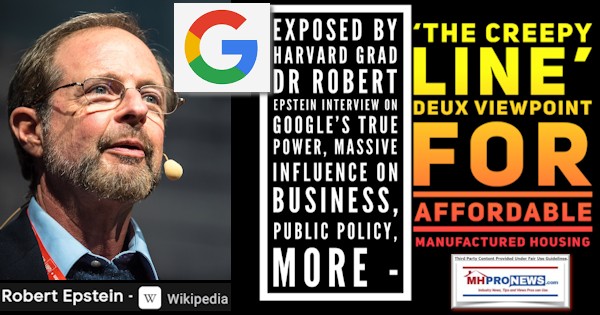
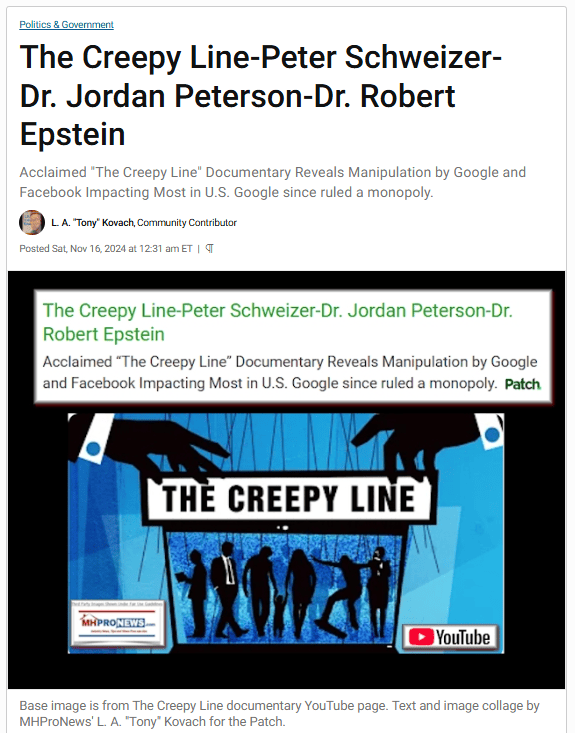
Additionally, MHProNews has been covering the topic of monopolization and its often-pernicious influences for some years. One recent article is linked below. MHProNews has informed readers that the problem of monopoly power in a given market, be it manufactured housing or many others, has numerous ripple effects that limit competition – almost by definition – and can drive up costs for consumers. More on this further below.

That post by Stylman on ZeroHedge continued like this.
The Algorithmic Age
Having explored the physical and psychological mechanisms of control in Part One, and their deployment through cultural engineering in Part Two, we now turn to their ultimate evolution: the automation of consciousness control through digital systems.
In my research on the tech-industrial complex, I’ve documented how today’s digital giants weren’t simply co-opted by power structures – many were potentially designed from their inception as tools for mass surveillance and social control. From Google’s origins in a DARPA-funded CIA project to Amazon’s founder’s familial ties to ARPA, these weren’t just successful startups that later aligned with government interests
What Tavistock discovered through years of careful study—emotional resonance trumps facts, peer influence outweighs authority, and indirect manipulation succeeds where direct propaganda fails—now forms the foundational logic of social media algorithms. Facebook’s emotion manipulation study and Netflix’s A/B testing of thumbnails (explored in detail later) exemplify the digital automation of these century-old insights, as AI systems perform billions of real-time experiments, continuously refining the art of influence at an unprecedented scale.
Just as Laurel Canyon served as a physical space for steering culture, today’s digital platforms function as virtual laboratories for consciousness control—reaching further and operating with far greater precision. Social media platforms have scaled these principles through ‘influencer’ amplification and engagement metrics. The discovery that indirect influence outperforms direct propaganda now shapes how platforms subtly adjust content visibility. What once required years of meticulous psychological study can now be tested and optimized in real time, with algorithms leveraging billions of interactions to perfect their methods of influence.
The manipulation of music reflects a broader evolution in cultural control: what began with localized programming, like Laurel Canyon’s experiments in counterculture, has now transitioned into global, algorithmically-driven systems. These digital tools automate the same mechanisms, shaping consciousness on an unprecedented scale
Netflix’s approach parallels Bernays’ manipulation principles in digital form – perhaps unsurprisingly, as co-founder Marc Bernays Randolph was Edward Bernays’ great-nephew and Sigmund Freud’s great-grand-nephew. Where Bernays used focus groups to test messaging, Netflix conducts massive A/B testing of thumbnails and titles, showing different images to different users based on their psychological profiles. Their recommendation algorithm doesn’t just suggest content – it shapes viewing patterns by controlling visibility and context, and context, similar to how Bernays orchestrated comprehensive promotional campaigns that shaped public perception through multiple channels. Just as Bernays understood how to create the perfect environment to sell products – like promoting music rooms in homes to sell pianos – Netflix crafts personalized interfaces that guide viewers toward specific content choices. Their approach to original content production similarly relies on analyzing mass psychological data to craft narratives for specific demographic segments.
More insidiously, Netflix’s content strategy actively shapes social consciousness through selective promotion and burial of content. While films supporting establishment narratives receive prominent placement, documentaries questioning official accounts often find themselves buried in the platform’s least-visible categories or excluded from recommendation algorithms entirely. Even successful films like What Is a Woman? faced systematic suppression across multiple platforms, demonstrating how digital gatekeepers can effectively erase challenging perspectives while maintaining the illusion of open access.
I experienced this censorship firsthand. I was fortunate enough to serve as a producer for Anecdotals, directed by Jennifer Sharp, a film documenting COVID-19 vaccine injuries, including her own. YouTube removed it on day one, claiming individuals couldn’t discuss their own vaccine experiences. Only after Senator Ron Johnson’s intervention was the film reinstated—a telling example of how platform censorship silences personal narratives that challenge official accounts.
This gatekeeping extends across the digital landscape. By controlling which documentaries appear prominently, which foreign films reach American audiences, and which perspectives get highlighted in their original programming, platforms like Netflix act as cultural gatekeepers – just as Bernays managed public perception for his corporate clients. Where earlier systems relied on human gatekeepers to shape culture, streaming platforms use data analytics and recommendation algorithms to automate the steering of consciousness. The platform’s content strategy and promotion systems represent Bernays’ principles of psychological manipulation operating at unprecedented scale.
MHProNews notes the following about Edward Bernay’s in the snapshot from left-leaning Wikipedia. Among the prior articles by MHProNews that peer into Bernay’s influence on American propaganda and “public relations” is linked below. Bernay’s book Propaganda is linked here.

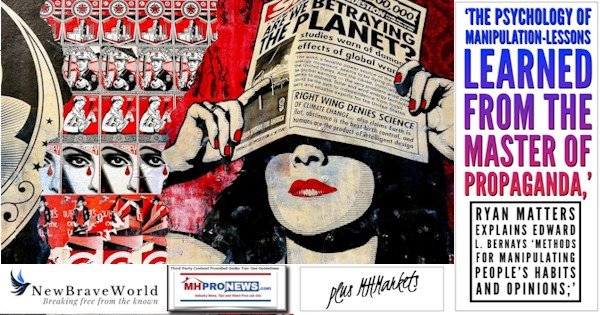
Joshua Stylman article via Zero Hedge, raised the topic of Netflix. MHProNews has noted that the Obamas got a fat contract with Netflix after they left the White House.

Back to Stylman’s insightful narrative via ZeroHedge.
Reality TV: Engineering the Self
Before social media turned billions into their own content creators, Reality TV perfected the template for self-commodification. The Kardashians exemplified this transition: transforming from reality TV stars into digital-age influencers, they showed how to convert personal authenticity into a marketable brand. Their show didn’t just reshape societal norms around wealth and consumption – it provided a masterclass in abandoning genuine human experience for carefully curated performance. Audiences learned that being oneself was less valuable than becoming a brand, that authentic moments mattered less than engineered content, that real relationships were secondary to networked influence.
This transformation from person to persona would reach its apex with social media, where billions now willingly participate in their own behavioral modification. Users learn to suppress authentic expression in favor of algorithmic rewards, to filter genuine experience through the lens of potential content, to value themselves not by internal measures but through metrics of likes and shares. What Reality TV pioneered – the voluntary surrender of privacy, the replacement of authentic self with marketable image, the transformation of life into content – social media would democratize at global scale. Now anyone could become their own reality show, trading authenticity for engagement.
MHProNews has reported on some of these topics in an arguably analogous way in posting articles about big tech and other influences over society that include foundations and nonprofits. There are many influences on culture and society, as the quote from Noam Chomsky and his thesis on Manufacturing Consent reminds us.

That will get more attention in a pending report that was bumped in favor of this topic.
Back to Stylman’s article via ZeroHedge.
Instagram epitomizes this transformation, training users to view their lives as content to be curated, their experiences as photo opportunities, their memories as stories to be shared with the public. The platform’s ‘influencer’ economy turns authentic moments into marketing opportunities, teaching users to modify their actual behavior – where they go, what they eat, how they dress – to create content that algorithms will reward. This isn’t just sharing life online – it’s reshaping life itself to serve the digital marketplace.
Even as these systems grow more pervasive, their limits are becoming increasingly visible. The same tools that enable manipulating cultural currents also reveal its fragility, as audiences begin to challenge manipulative narratives.
Again, MHProNews has raised the cautionary flag by pointing out that the U.S. and some so-called Western cultures have in some ways adopted the Communist Chinese Social Credit system.
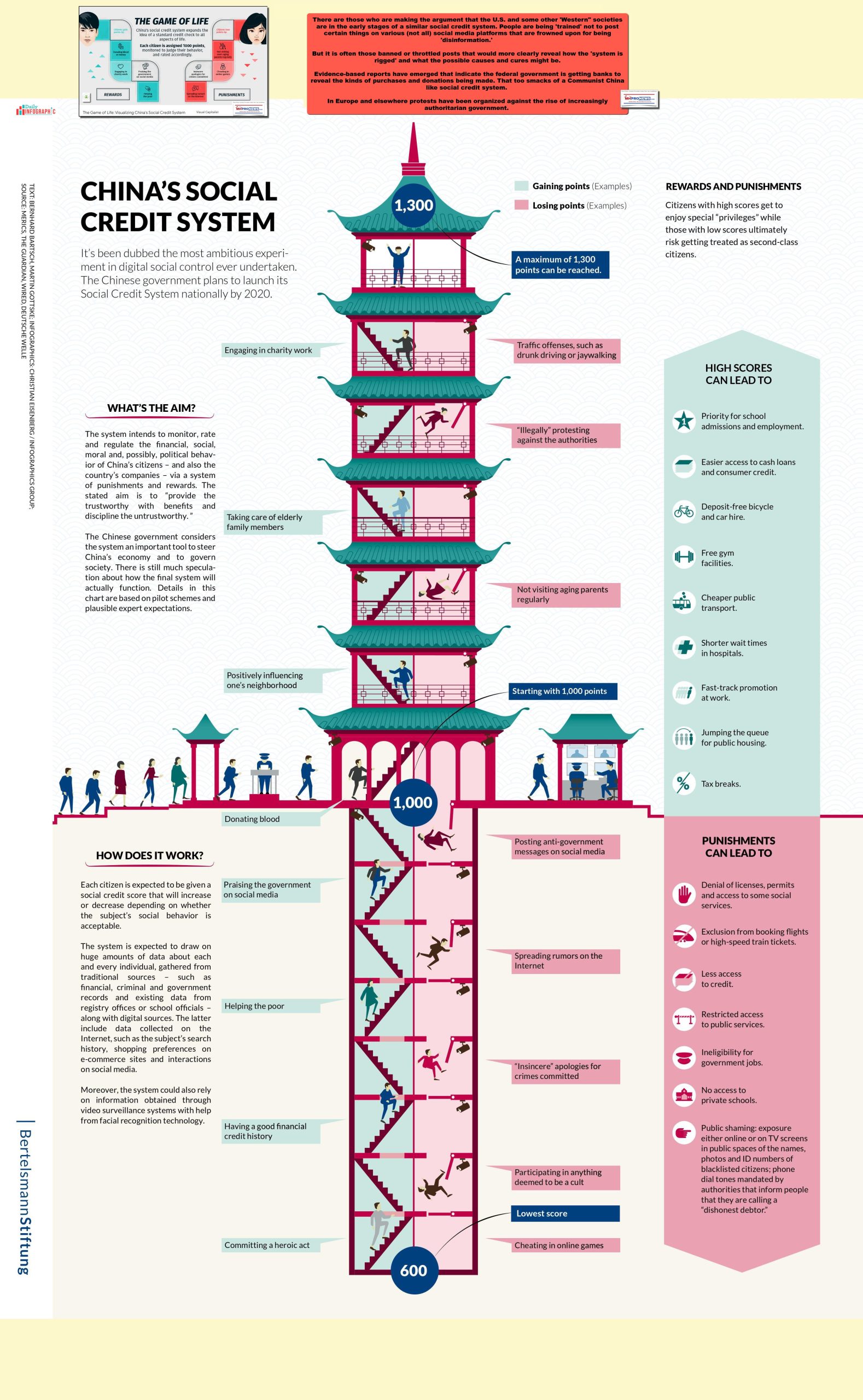

More recently MHProNews noted in 2024 that then former President Trump was being punished by the legal system in a range of cases that some legal experts felt went beyond U.S. norms. Political punishments were being handed out to Trump and some of his associates, including on Trump’s business interests in ways that some argued could have a chilling effect on businesses considering going into New York, for example. That was an out in the open the process is the punishment example that still needs to be sorted out.

When such efforts are viewed through the lens of a ‘class traitor’ (i.e.: Trump) being punished by the insiders who have “rigged the system” some of these issues come into clearer focus.

When MHProNews has raised the point that access to credit and information is a key point in understanding the modern era by using this quote from Danny Glover: “It’s not only a monopoly of wealth; it’s a monopoly of information as well.”
Returning to Stylman’s article on ZeroHedge.
Cracks in the System
Despite its sophistication, the system of control is beginning to show cracks. Increasingly, the public is pushing back against blatant attempts at cultural engineering, as evidenced by current consumer and electoral rejections.
Recent attempts at obvious cultural exploitation, such as corporate marketing campaigns and celebrity-driven narratives, have begun to fail, signaling a turning point in public tolerance for manipulation. When Bud Light and Target – companies with their own deep establishment connections – faced massive consumer backlash in 2023 over their social messaging campaigns, the speed and scale of the rejection marked a significant shift in consumer behavior. Major investment firms like BlackRock faced unprecedented pushback against ESG initiatives, seeing significant outflows which forced them to recalibrate their approach. Even celebrity influence lost its power to shape public opinion – when dozens of A-list celebrities united behind one candidate in the 2024 election, their coordinated endorsements not only failed to sway voters but may have backfired, suggesting a growing public fatigue with manufactured consensus.
Again, this is analogous to what MHProNews has reported, often using similar topics as well as more manufactured housing specific ones.





Per Stylman’s via ZeroHedge.
The public is increasingly recognizing these manipulation patterns. When viral videos expose dozens of news anchors reading identical scripts about ‘threats to our democracy,’ the facade of independent journalism crumbles, revealing the continued operation of systematic narrative control. Legacy media’s authority is crumbling, with frequent exposures of staged narratives and misrepresented sources revealing the persistence of centralized messaging systems.
Even the fact-checking industry, designed to bolster official narratives, faces growing skepticism as people discover these ‘independent’ arbiters of truth are often funded by the very power structures they claim to monitor. The supposed guardians of truth serve instead as enforcers of acceptable thought, their funding trails leading directly to the organizations they’re meant to oversee.
MHProNews has gone into greater depth and details in articles, while simultaneously cutting the numbers of daily reports, often combining seemingly unrelated topics into one article. The reasoning is complex, but can be described as attempting to counter the manipulation that Joshua Stylman via ZeroHedge has described.

That said, it is a fair question how much of the public is becoming aware of these interconnected woes.
Per Stylman.
The public awakening extends beyond corporate messaging to a broader realization that supposedly organic social changes are often engineered. For example, while most people only became aware of the Tavistock Institute through recent controversies about gender-affirming care, their reaction hints at a deeper realization: that cultural shifts long accepted as natural evolution might instead have institutional authors. Though few still understand Tavistock’s historic role in shaping culture since our grandparents’ time, a growing number of people are questioning whether seemingly spontaneous social transformations may have been, in fact, deliberately orchestrated.
This growing recognition signals a fundamental shift: as audiences become more conscious of manipulation methods, the effectiveness of these control systems begins to diminish. Yet the system is designed to provoke intense emotional responses – the more outrageous the better – precisely to prevent critical analysis. By keeping the public in a constant state of reactionary outrage, whether defending or attacking figures like Trump or Musk, it successfully distracts from examining the underlying power structures these figures operate within. The heightened emotional state serves as a perfect shield against rational inquiry.
Before examining today’s digital control mechanisms in detail, the evolution from Edison’s hardware monopolies to Tavistock’s psychological operations to today’s algorithmic control systems reveals more than a natural historical progression – it shows how each stage intentionally built upon the last to achieve the same goal. Physical control of media distribution evolved into psychological manipulation of content, which has now been automated through digital systems. As AI systems become more sophisticated, they don’t just automate these control mechanisms – they perfect them, learning and adapting in real-time across billions of interactions. We can visualize how distinct domains of power – finance, media, intelligence, and culture – have converged into an integrated grid of social control. While these systems initially operated independently, they now function as a unified network, each reinforcing and amplifying the others. This framework, refined over a century, reaches its ultimate expression in the digital age, where algorithms automate what once required elaborate coordination between human authorities.
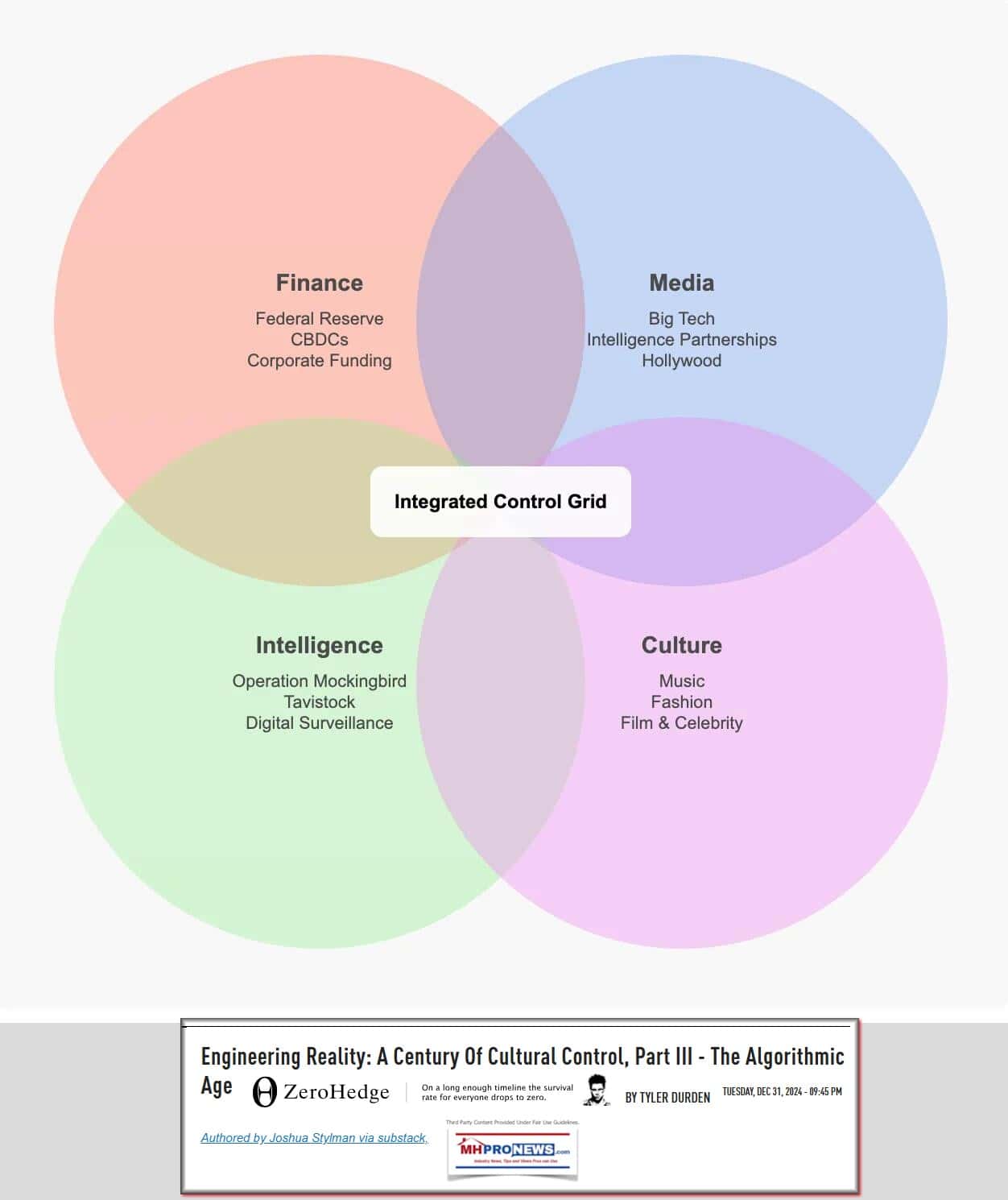
Stylman has pulled together in his illustration above a useful “Integrated Control Grid.” Each of those factors influence society and also businesses and specific professions. MHProNews would note that in addition, there are the influences of nonprofits and foundations, the education system, government, and the presence (or absence) of a robust faith community that helps inform and shape (or not) a society. MHProNews and our MHLivingNews sister site has probed those subjects in reports like the ones linked below.

The Digital Endgame
Today’s digital platforms represent the culmination of control methods developed over the past century. Where their researchers once had to manually study group dynamics and psychological responses, AI systems now perform billions of real-time experiments, continuously refining their influence techniques through massive data analysis and behavioral tracking. What Thomas Edison achieved through physical control of films, modern tech companies now accomplish through algorithms and automated content moderation.
The convergence of surveillance, algorithms, and financial systems represents not just an evolution in technique but an escalation in scope. This convergence appears by design. Consider that Facebook launched the same day DARPA shut down ‘LifeLog,‘ their project to track a person’s ‘entire existence’ online. Or that major tech platforms now employ numerous former intelligence operatives in their ‘Trust & Safety’ teams, determining what content gets amplified or suppressed.
Social media platforms capture detailed behavioral data, which algorithms analyze to predict and shape user actions. This data increasingly feeds into financial systems through credit scoring, targeted advertising, and emerging Central Bank Digital Currencies (CBDCs). Together, these create a closed loop where surveillance refines targeting, shapes economic incentives, and enforces compliance with dominant order norms at the most granular level.
This evolution manifests in concrete ways:
- Edison’s infrastructure monopoly became platform ownership
- Tavistock’s psychology studies became social media algorithms
- Operation Mockingbird’s media infiltration became automated content moderation
- The Hays Code’s moral controls became ‘community guidelines
More specifically, Edison’s original blueprint for control evolved into digital form:
- His control of production equipment became platform ownership and cloud infrastructure
- Theater distribution control became algorithmic visibility
- Patent enforcement became Terms of Service
- Financial blacklisting became demonetization
- His definition of ‘authorized’ content became ‘community standards'”
Edison’s patent monopoly allowed him to dictate which films could be shown and where – just as today’s tech platforms use Terms of Service, IP rights, and algorithmic visibility to determine what content reaches audiences. Where Edison could simply deny theaters access to films, modern platforms can quietly reduce visibility through “shadow banning” or demonetization.
MHProNews has delved into topics like market manipulation and abuses by various types of monopolies for some years.
At first, it admittedly may have seemed like lighting a candle in the darkness. But as the sheer volume of those individual candles of light from each article accumulated, a body of evidence and an increased understanding of the nuances arose. Beyond what Joshua Stylman via ZeroHedge wrote, and with no slam on either of those sources intended, this writer and MHProNews has periodically inserted the spiritual or religious component of reality into our reports for years. The reasons are many, but include the notion that part of what the Blob appears to attempt is to ignore or even mock faith in or by influencers, including some in media. The antidote to that should be to look at the relevance of insights from faith, including the question does God exist? By grappling with that topic on a periodic basis, it is our hope to show in a pragmatic and practical way why faith and morals matters.


Back to Stylman’s narrative.
This evolution from manual to algorithmic control reflects a century of refinement. Where the Hays Code explicitly banned content, AI systems now subtly deprioritize it. Where Operation Mockingbird required human editors, recommendation algorithms now automatically shape information flow. The mechanisms haven’t disappeared—they’ve become invisible, automated, and far more effective.
The COVID-19 pandemic demonstrated how thoroughly and quickly modern control systems could manufacture consensus and enforce compliance. Within weeks, established scientific principles about natural immunity, outdoor transmission, and focused protection were replaced by a new orthodoxy. Social media algorithms were programmed to amplify fear-based content while suppressing alternative viewpoints, while news outlets coordinated messaging to maintain narrative control, and financial pressures ensured institutional compliance. Just as Rockefeller’s early capture of medical institutions shaped the boundaries of acceptable knowledge a century ago, the pandemic response demonstrated how thoroughly this system could activate in a crisis. The same mechanisms that once defined ‘scientific’ versus ‘alternative’ medicine now determined which public health approaches could be discussed and which would be systematically suppressed.
The Great Barrington Declaration scientists found themselves erased not just through typical censorship, but through the invisible hand of algorithmic suppression – their views buried in search results, their discussions flagged as misinformation, their professional reputations questioned by coordinated media campaigns. This trifecta of suppression rendered dissenting perspectives effectively invisible, demonstrating how modern platforms can converge with state power to erase opposition while maintaining the illusion of independent oversight. Most users never realize what they’re not seeing – the most effective censorship is invisible to its targets.
MHProNews explored the intersection of several of these topics during the COVID19 outbreak. Items that some in mainstream media overlooked or downplayed, which in several cases were later were confirmed or admitted to, were correctly covered by MHProNews and some others in alternative media correctly from the start. Some of these topics may pop back up again during Trump 2.0. If so, longer term and detail minded readers heard about it here already.




Back to Stylman’s narrative.
Elon Musk’s acquisition of Twitter offered a crack of light, exposing previously hidden practices like shadow banning and algorithmic content suppression through the release of the Twitter Files. These revelations demonstrated how thoroughly platforms had integrated government influence into their moderation policies – whether through direct pressure or voluntary compliance – erasing dissent under the guise of maintaining community standards.’ Yet even Musk acknowledged the limits of free expression within this framework, stating that ‘freedom of speech doesn’t mean freedom of reach.’ This admission underscores the enduring reality: even under new leadership, platforms remain bound by the algorithms and incentives that shape visibility, influence, and economic viability.
From MHProNews were items related to the Twitter Files revelations like what followed below.
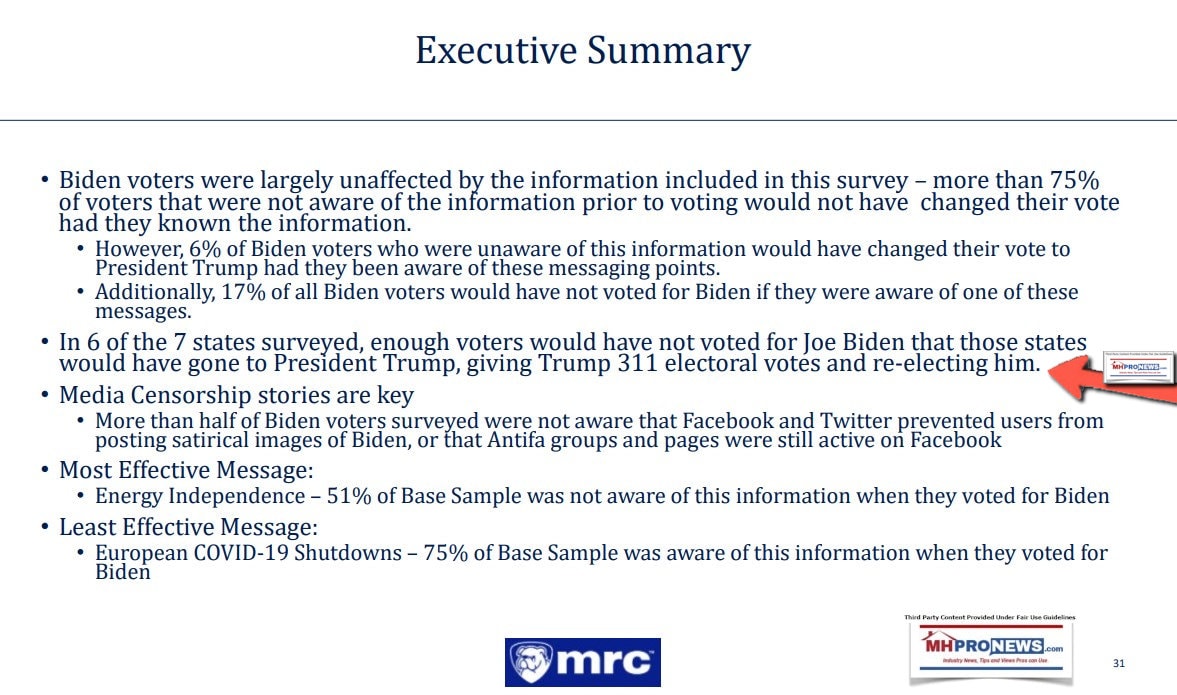

Returning to Stylman’s article.
Perhaps the ultimate expression of this evolution is the proposed introduction of Central Bank Digital Currencies (CBDCs), which transform social control mechanisms into financial infrastructure. The merger of ESG metrics with digital currency creates unprecedented granular control – every purchase, every transaction, every economic choice becomes subject to automated social compliance scoring. This fusion of financial surveillance with behavioral control represents the ultimate expression of the control systems that began with Edison’s physical monopolies. By embedding surveillance into currency itself, governments and corporations gain the ability to monitor, restrict, and manipulate transactions based on compliance with official criteria – from carbon usage limits to diversity metrics to social credit scores. These systems could render dissent not just punishable, but economically impossible—restricting access to basic necessities like food, housing, and transportation for those who fail to comply with approved behaviors.
MHProNews explored CBDCs in the report linked below. Note that that and several of these other topics have been downplayed, ignored, or barely (and perhaps incorrectly) mentioned by others in MHVille trade media.

Next, Stylman said this.
What began with Tavistock’s careful study of mass psychology, tested through Facebook’s crude emotion experiments, and perfected through modern algorithmic systems, represents more than a century of evolving social control. Each stage built upon the last: from physical monopolies to psychological manipulation to digital automation. Today’s social media platforms don’t just study human behavior – they shape it algorithmically, automating mass psychological manipulation through billions of daily interactions.
Unplugging from the Matrix: A Path Back to Reality
Understanding these systems is the first step toward liberation. As the machinery of control reaches its peak, so too does the opportunity for resistance. The endgame for centralized power presents a paradox: the same systems designed to limit freedom also expose their own vulnerabilities.
MHProNews well said. By exposing the manipulation the path back to more authentic living and more freedom may be achieved. The modern Babel may be more sophisticated than the ancient biblical Tower of Babel, but human nature is still the same. There is no guarantee that this generation will be successful, but the next or future generations can be precisely because God saw it all in advance and has provided the graces needed for humanity with free will to overcome it.
While the evolution from Edison’s physical monopolies to today’s invisible algorithmic controls may feel overwhelming, it reveals a crucial truth: these mechanisms are constructed—and what is constructed can be dismantled or circumvented.
We can already see glimmers of resistance. As I’ve observed in my investigation of Big Tech’s origins, people are increasingly demanding transparency and authenticity – and once they see these control systems, they don’t unsee them. Public backlash against obvious ideological sculpting—from corporate virtue-signaling campaigns to platform censorship—suggests an awakening to these methods of control. The public rejection of corporate news networks in favor of independent journalism, the mass exodus from manipulative social media platforms to decentralized alternatives, and the growing movement toward local community building all demonstrate how awareness leads to action. The rise of platforms committed to free speech, even within centralized systems, shows that alternatives to algorithmic manipulation are possible. By championing transparency, reducing reliance on automated content moderation, and supporting the open exchange of ideas, these platforms challenge the status quo and push back against the dominance of centralized narratives. Building on these principles, truly decentralized networks represent our best hope for resistance: by eliminating gatekeepers entirely, they offer the greatest potential to counter hierarchical control and empower authentic expression.
MHProNews is similarly hopeful as Stylman.

The battle for freedom of consciousness is now our most fundamental struggle. Without it, we are not autonomous actors but non-player characters (NPCs) in someone else’s game, making seemingly free choices within carefully constructed parameters. Each time we question an algorithmic recommendation or seek out independent voices, we crack the control matrix. When we build in person local communities and support decentralized platforms, we create spaces beyond algorithmic manipulation. These aren’t just acts of resistance – they’re steps toward reclaiming our autonomy as conscious human actors rather than programmed NPCs.
The choice between authentic consciousness and programmed behavior requires daily discernment. We can passively consume curated content or actively seek diverse perspectives. We can accept algorithmic suggestions or consciously choose our information sources. We can isolate ourselves in digital bubbles or build real-world communities of resistance.
Our liberation begins with recognition: these systems of control, though powerful, are not inevitable. They were constructed, and they can be dismantled. By embracing creativity, fostering authentic connection, and restoring our sovereignty, we don’t just resist the control matrix – we reclaim our fundamental right to author our own destiny. The future belongs to those aware enough to see the system, brave enough to reject it, and creative enough to build something better.
MHProNews tends to agree with what Joshua Stylman via ZeroHedge wrote, for reasons found in the linked articles. Truth and reality are discernible. Articles and authentic vs manipulative fact checks and analysis like this are a necessary means to an end. Perhaps a younger generation can find, digest and awaken to what the tiny fraction of the so-called one percent and their minions have in mind and develop an intellectual capacity to discern quickly and accurately based upon fundamental truths instead of artificial constructs.
























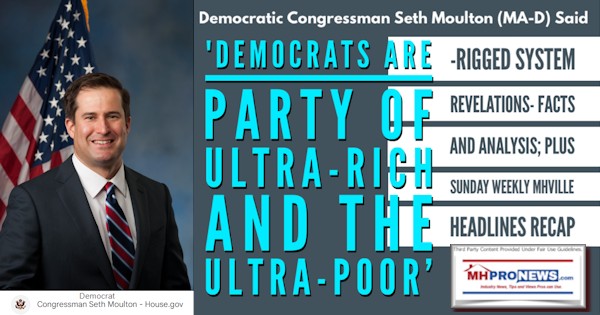

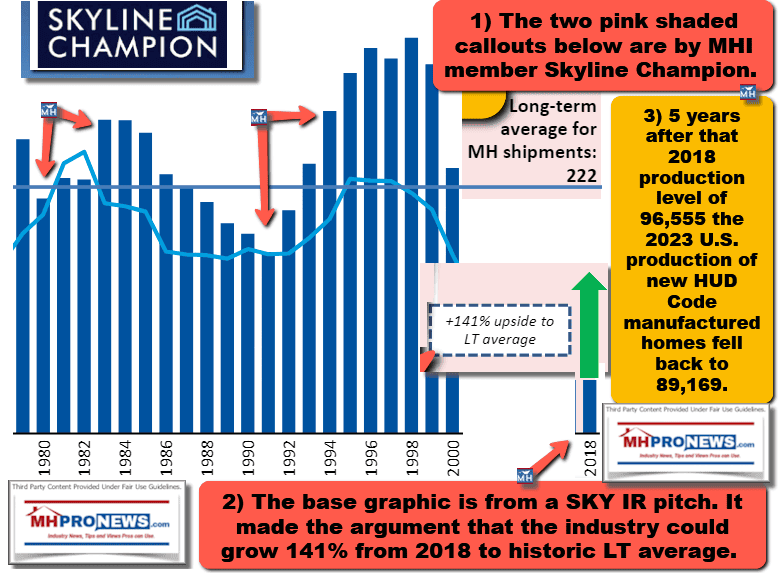







Again, our thanks to free email subscribers and all readers like you, as well as our tipsters/sources, sponsors and God for making and keeping us the runaway number one source for authentic “News through the lens of manufactured homes and factory-built housing” © where “We Provide, You Decide.” © ## (Affordable housing, manufactured homes, reports, fact-checks, analysis, and commentary. Third-party images or content are provided under fair use guidelines for media.) See Related Reports, further below. Text/image boxes often are hot-linked to other reports that can be access by clicking on them.)

By L.A. “Tony” Kovach – for MHProNews.com.
Tony earned a journalism scholarship and earned numerous awards in history and in manufactured housing.
For example, he earned the prestigious Lottinville Award in history from the University of Oklahoma, where he studied history and business management. He’s a managing member and co-founder of LifeStyle Factory Homes, LLC, the parent company to MHProNews, and MHLivingNews.com.
This article reflects the LLC’s and/or the writer’s position and may or may not reflect the views of sponsors or supporters.
Connect on LinkedIn: http://www.linkedin.com/in/latonykovach
Related References:
The text/image boxes below are linked to other reports, which can be accessed by clicking on them.’












